Taking a Chance on Doilies
By A Guest Writer – 1 CommentA Guest Post by Suzann Thompson.
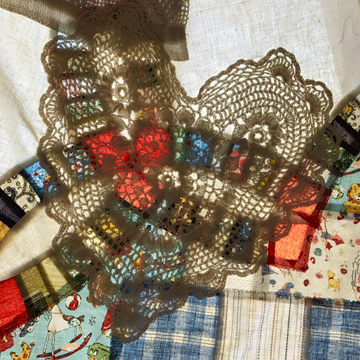
At a textile art exhibit, an acquaintance said to me, “I have all these doilies from my grandmother, but I don’t really know what to do with them.”
That casual comment from a few years ago is largely responsible for Celebrate Doilies! which is a traveling exhibit of doily art, poetry, and heritage, debuting in July 2017 in Stephenville, Texas.
To prepare for the exhibit, I have spent the last year talking to families in my area and beyond about their crochet heirlooms. They show me beautiful crocheted pieces and reminisce with me about the crocheters they have known. Their stories will be in the Celebrate Doilies! exhibit.
Poet Sandi Horton and I happened to cross paths at an arts weekend where we both made presentations. Sandi wrote poems about her rich family heritage of crochet. Her work will be exhibited in the Celebrate Doilies! show.
You can read more details about Celebrate Doilies! and one of Sandi’s poems here.
If a chance comment started the process and a chance meeting enhanced the original idea, the coincidences didn’t stop there. Meet “Hope Chest,” a product of chance events.
Hope Chest
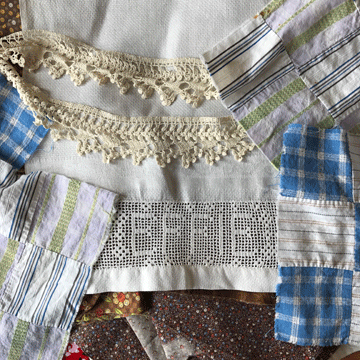
One of my weekly quilting/crafting buddies, Sonja, was paring down her collection. She brought her cleaned-out things to our meeting for the group to sort through and take.
I took home some hand-pieced nine-patch squares and a tea towel with the name “Effie” in a crocheted panel. So that was coincidence number one.
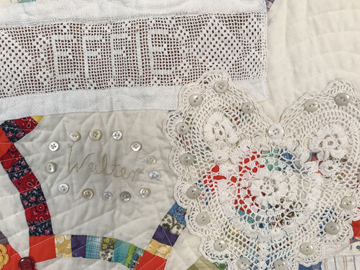
The tea towel looked like something a young lady might make for her hope chest. I created a possible history for the piece. Obviously, Effie was the young lady in the story. She had her eye on Walter, the brother of one of her friends. I imagined Effie and her friend crocheting and embroidering monograms on linens for their hope chests. While they worked, Effie hoped Walter might happen to stop by to say hello.
Around this time, I was moving into a new studio, sorting bags of supplies into their rightful places. Coincidence number two was the fact that I actually knew where to find a fragment of a double wedding ring quilt from an estate sale. I easily found a vintage crocheted basket motif, a crocheted trim, and a couple of small crocheted motifs, as well.
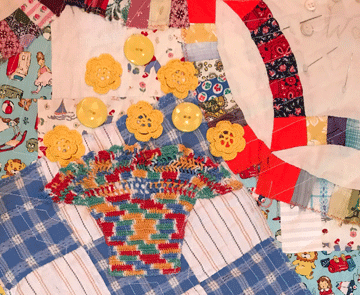
Sandi Horton and I met in March to discuss poetry and crochet for Celebrate Doilies! She had many doilies made by her mother and both grandmothers. “Here, take some of these,” she told me. She said she would be pleased if I could use her family crochet in my artwork. Coincidence number three: Sandi gave me a heart-shaped doily crocheted by her mother.
With the addition of fabric in my collection (also from a friend’s clean-out session), I had all the pieces I needed to make “Hope Chest,” where Effie dreams of life with Walter: a wedding, children, flowers, and pretty handmade things.
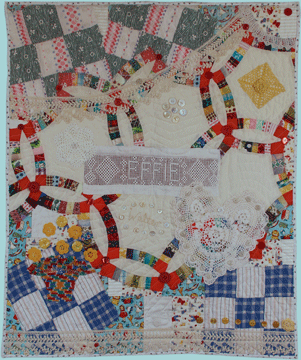
Please Support This Effort
Celebrate Doilies! is open to the public, free of charge. Find show venues, dates, and other details here.
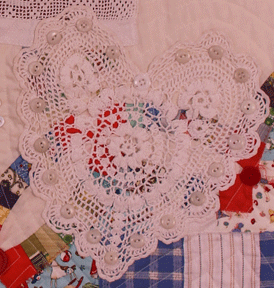
To help with the expenses of mounting this exhibit, I started a Kickstarter crowd-funding campaign for Celebrate Doilies! Please consider donating a little or a lot to the Celebrate Doilies project by June 21. Contributors can choose to receive rewards for their support.
If you can’t donate at this time, but would like to help, please share this post on Facebook, Twitter, Instagram, Pinterest, and other social media platforms you like.
I appreciate every bit of help that supports Celebrate Doilies!
Process Notes
To attach items like the crocheted basket to fabric, I use the very light MistyFuse® brand fusible web. After fusing, I machine-sew around the edges of the crocheted piece. (Find MistyFuse here.)
The heart doily was too lacy to attach to the quilt top with fusible web, so I used Bo-Nash fusible powder instead. (Find Bo-Nash powder here.)
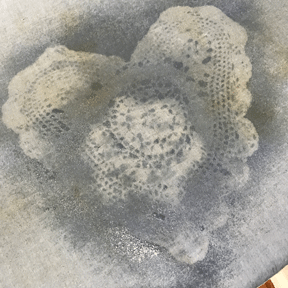
To use the fusible powder, first spray the wrong side of the doily with water. I like the shadow left by the spray, pictured here.
Cover your work surface. Place the doily, wet side up, on the surface. Sprinkle thoroughly with powder. Shake off excess powder. At this point, I funnel the excess powder back into the Bo-Nash canister.
Following the instructions that come with the fusible powder, place the doily, powder side down, where you want to fuse it on the fabric or quilt top. Pin around the edges. Cover the doily with a fiberglass sheet and press.
Since the first pressing is from the top side of the doily, the powder underneath may not fuse well. This is why I suggest pinning the edges. Making sure your ironing surface is protected, carefully turn over the piece and press again from the back. This should adhere the doily well enough for you to sew it in place.
I normally use a zig-zag stitch around the edges of crochet. Later I quilt through the doily with a straight sewing stitch, using a walking foot on my sewing machine.
Suzann Thompson is a long-time crocheter and knitter. She has written three books about crochet: Crochet Bouquet: Easy Designs for Dozens of Flowers, Crochet Garden: Bunches of Flowers, Leaves, and Other Delights, and Cute Crochet World: A Little Dictionary of Crocheted Critters, Folks, Food & More. Lots of the motifs from her books find their way into her artwork. You can see more of Suzann’s work at textilefusion.com.
Suzann lives in a compressed earth block house in rural Texas, about half a mile from her studio and office, which she shares with her husband.


Thank you so much for posting this, Rachel!